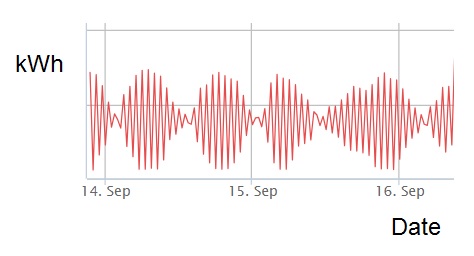Jonathan M., a reader of my Energy Management Register bulletins, sent me an interesting query about some electricity meter readings from a closed building. Here is a picture of its half-hourly consumption over a couple of days and you can understand why he thought there must be some kind of meter error “possibly involving harmonics”:
To me the pattern was reminiscent of the ‘beating’ that you get between two sounds or electrical oscillators of similar frequency. How could that be? Figuring that one of the frequencies must be the meter-reading frequency (2 per hour) I speculated that a single load coming on and off regularly at approximately the same frequency would explain the observed waveform. Let’s put some numbers to that. Imagine a 6kW immersion heater that’s cycling on and off with no hot water being drawn. Now suppose it just happens to be on for 31 minutes and then off for 30 minutes each time. Every so often there would be a half-hour in which the heater is on for the whole time (consuming 3 kWh), followed by one in which it only registers for one-thirtieth of the interval (so 0.1 kWh). In the chart, those are the successive readings with the biggest swings. Fifteen on-off cycles later consumption would start 15 minutes into the half-hour meter interval, registering 1.5 kWh, with an equal 1.5 kWh in the following interval (roughly). This would yield no swing between successive readings. After a further fifteen on-off cycles we’d be back to the situation where 0.1 kWh is consumed in one interval and 3 kWh in the next. Overall this would give us a pattern of alternating high and low half-hourly consumptions with the magnitude of the swings varying between maxima and minima with a 15-hour periodicity, with the minim consumptions close to zero and the maxima roughly double the mean.
Amazingly (and I still cannot quite believe it) I’ve since heard that my diagnosis was correct: an immersion heater had indeed been left energised in the unoccupied building.
